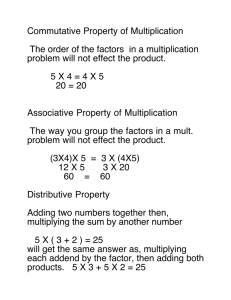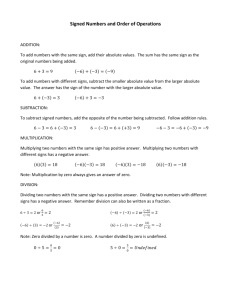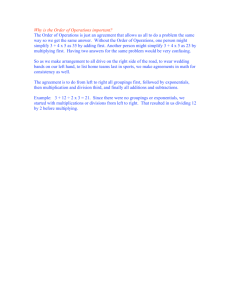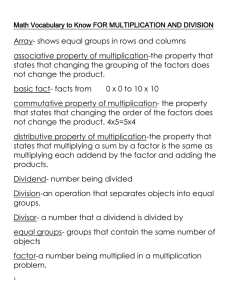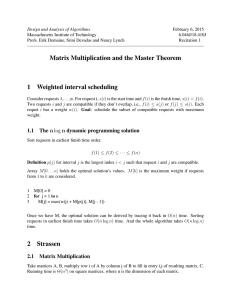Master's Thesis Proposal 1 Lower Bounds for Matrix Multiplication Tommy Färnqvist
advertisement
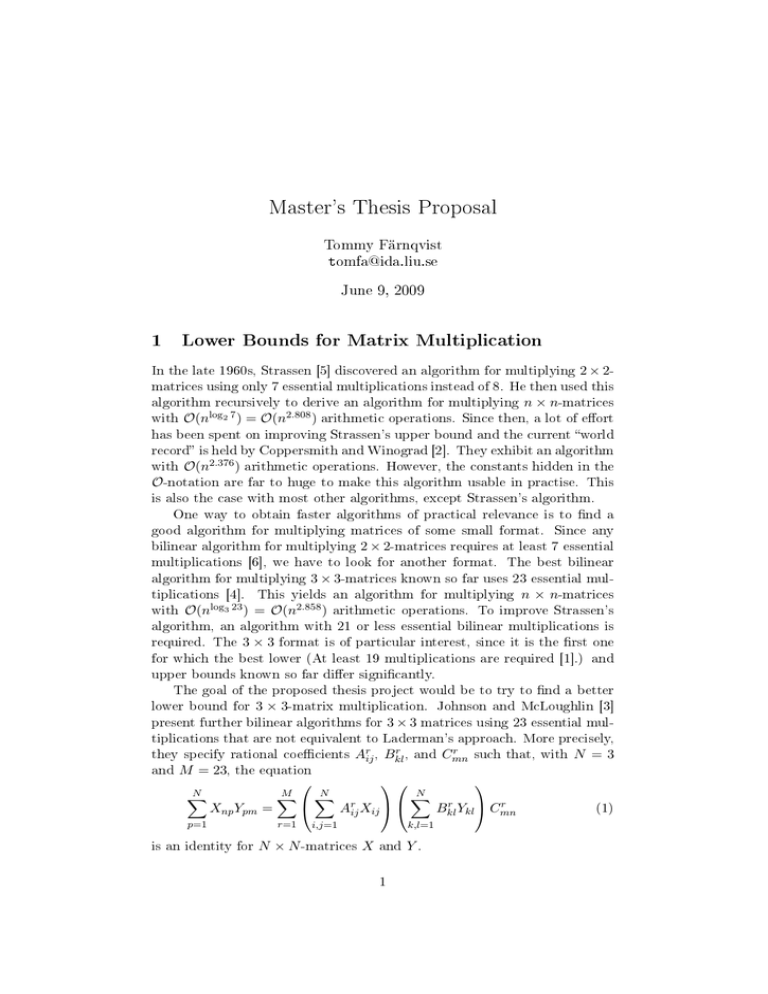
Master's Thesis Proposal
Tommy Färnqvist
tomfa@ida.liu.se
June 9, 2009
1
Lower Bounds for Matrix Multiplication
In the late 1960s, Strassen [5] discovered an algorithm for multiplying
2 × 2-
matrices using only 7 essential multiplications instead of 8. He then used this
algorithm recursively to derive an algorithm for multiplying
with
O(nlog2 7 ) = O(n2.808 )
n × n-matrices
arithmetic operations. Since then, a lot of eort
has been spent on improving Strassen's upper bound and the current world
record is held by Coppersmith and Winograd [2]. They exhibit an algorithm
with
O(n2.376 )
O-notation
arithmetic operations. However, the constants hidden in the
are far to huge to make this algorithm usable in practise. This
is also the case with most other algorithms, except Strassen's algorithm.
One way to obtain faster algorithms of practical relevance is to nd a
good algorithm for multiplying matrices of some small format.
bilinear algorithm for multiplying
2 × 2-matrices
multiplications [6], we have to look for another format.
algorithm for multiplying
tiplications [4].
log3 23 )
with O(n
3 × 3-matrices
The best bilinear
known so far uses 23 essential mul-
This yields an algorithm for multiplying
=
Since any
requires at least 7 essential
n × n-matrices
O(n2.858 ) arithmetic operations. To improve Strassen's
algorithm, an algorithm with 21 or less essential bilinear multiplications is
required. The
3×3
format is of particular interest, since it is the rst one
for which the best lower (At least 19 multiplications are required [1].) and
upper bounds known so far dier signicantly.
The goal of the proposed thesis project would be to try to nd a better
lower bound for
3 × 3-matrix
multiplication. Johnson and McLoughlin [3]
present further bilinear algorithms for
3×3
matrices using 23 essential mul-
tiplications that are not equivalent to Laderman's approach. More precisely,
they specify rational coecients
and
M = 23,
N
X
r ,
Arij , Bkl
and
r
Cmn
such that, with
N =3
the equation
Xnp Ypm =
p=1
is an identity for
M
X
N
X
r=1
Arij Xij
i,j=1
N × N -matrices X
N
X
k,l=1
and
1
Y.
r
r
Bkl
Ykl Cmn
(1)
A necessary and sucient condition for (1) to hold identically in
Y
X
and
is that the coecients satisfy
M
X
r r
Arij Bkl
Cmn = δmi δjk δln .
(2)
r=1
This system of polynomial equations is where the thesis project is proposed
to make its attack on trying to prove better lower bounds for
3 × 3-matrix
multiplication. Namely, if one could show that the above system does not
have any solution for
N = 3
and some
M ∈ {20, 21, 22},
this would be a
proof of a new lower bound. This attack would rely on the hope of low degree
of the Hilbert's Nullstellensatz certicates for the above polynomial systems
and on large-scale linear-algebra computation. It seems plausible that this
project would even need to use computing resources from the National Supercomputer Centre in Linköping.
1.1
Contact
Does this sound like an interesting project? Would you like to know more
about it? Do not hesitate to contact the author!
References
[1] M. Bläser. On the complexity of the multiplication of matrices of small
formats. J. Complexity, 19:4360, 2003.
[2] D. Coppersmith and S. Winograd. Matrix multiplication via arithmetic
progression. J. Symbolic Comput., 9:251280, 1990.
[3] R. Johnson and A. McLoughlin. Noncommutative bilinear algorithms for
3x3 matrix multiplication. SIAM J. Comput,, 15(2):595603, 1986.
[4] J. Laderman. A noncommutative algorithm for multiplying 3x3-matrices
using 23 multiplications. Bull. Amer. Math. Soc., 82:180182, 1976.
[5] V. Strassen. Gaussian elimiation is not optimal. Numer. Math., 13:354
356, 1969.
[6] S. Winograd. On multiplication of 2x2-matrices. Linear Algebra Appl.,
4:381388, 1971.
2

